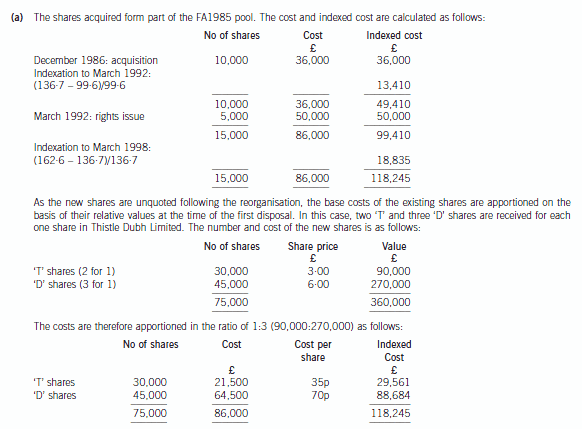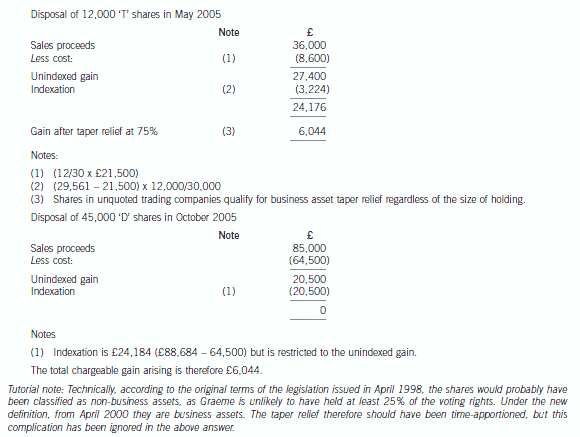天津市考生:如何利用零散时间学习ACCA?
发布时间:2020-01-10
在我国职称会计师考试中,ACCA考试属于难度比较大的考试,由于严苛的报考条件,备考ACCA考试的朋友大多数都是工作比较忙碌的上班族,那么如何在繁忙的工作中合理安排备考时间对于考生来说就非常重要了。除去完整系统的备考时间外,生活中零散时间也是能够备考的,今天就来教大家如何高效利用零散时间学习ACCA考试,大家可以作为参考。
每天至少一道题
ACCA考试的类型有很多种,主要考察应试人员分析、解决财务工作的能力,同时对计算能力和语言能力也是极大的挑战。所以在平时的备考中是一定缺少不了习题的辅助的。建议大家每天至少要做一套ACCA真题训练,每道小问控制在8分钟左右,这就足够大家利用空闲时间进行做题。
生活空档看考点
在上班路上看新闻时间,午休后的看剧时间在备考期间大家都可以转换成“高会学习时间”,带上《轻松过关》辅导书,看里面的“考点精讲”,让你在短时间内了解学习内容。你可以选择将学过的知识点复习一遍,或者将要学习的知识点提前预习一遍,要知道只有多一份努力才能多一份胜算。
备考笔记随身带
很多考生在备考中有记笔记或者是记错题本的好习惯,将整理的内容随身携带,空闲时间可以随时拿出来进行学习也是不错的选择。选择自己整理的笔记可以加深学习的印象,在考试的过程中也能当成考试资料带入考场,寻找知识点也会更快。
用完整时间来学习,用零散时间来备考,两者结合高效备考!
以上就是为大家准备的备考方法,希望对大家有所帮助,预祝大家都能轻松过ACCA考试~加油~
下面小编为大家准备了 ACCA考试 的相关考题,供大家学习参考。
2 Traditionally, the only objective of a business was to make a profit. However, some writers have suggested that this idea is simplistic and that profitability is only one objective amongst many.
Required:
State and explain Drucker’s eight classifications of objectives.
(15 marks)
2 For the complex, modern business, the view that the single objective of business is to make a profit is regarded by many writers as simplistic. Peter Drucker has argued that for a business to be successful, it must address a number of objectives.
Drucker was one of the first writers to identify the dangers of the single objective of profit maximisation. Concentrating on a single objective (invariably profit) is not only unproductive but potentially harmful to the organisation and can endanger the survival of the business and seriously undermine its future. He argues that business organisations have in fact eight objectives, all of which must be addressed concurrently. These eight objectives are particularly relevant to management, bringing together as they do the need to address all the issues with which the organisation is concerned.
Market standing is the need to identify and maintain market share and to ensure the development of new products to maintain share. Without market standing, no organisation can succeed.
Innovation is the need to develop and find new products and processes; no business can survive on providing the same product or service over the long term. Innovation is fundamental to understanding growth; organisations grow by developing innovative differences to their competitors.
Productivity and ‘contributed value’ recognises the need for efficiency and the efficient use of business resources.
Physical and financial resources is a recognition of the need to use the correct and appropriate financial resources.
Profitability. The word ‘profit’ does not appear, but ‘profitability’. Here there are three important determinants, profitability as a measure of effectiveness (many businesses make a profit which in fact is a poor return on the effort produced), the need for profit so that the business can be self-financing and the need to attract new capital.
Manager performance and development is the explicit recognition that the business requires objectives and that management activity can be linked directly to those objectives.
Worker performance and attitude is recognition that it is vital to measure the performance of the workforce by such means as labour turnover. However, worker attitude is more difficult to measure, but should be attempted.
Public responsibility has become an issue in the twenty-first century. Any business needs to be aware that it is a part of the community within which it operates and is therefore part of a wider social system.
2 Graeme, aged 57, is married to Catherine, aged 58. They work as medical consultants, and both are higher rate
taxpayers. Barry, their son, is aged 32. Graeme, Catherine and Barry are all UK resident, ordinarily resident and
domiciled. Graeme has come to you for some tax advice.
Graeme has invested in shares for some time, in particular shares in Thistle Dubh Limited. He informs you of the
following transactions in Thistle Dubh Limited shares:
(i) In December 1986, on the death of his grandmother, he inherited 10,000 £1 ordinary shares in Thistle Dubh
Limited, an unquoted UK trading company providing food supplies for sporting events. The probate value of the
shares was 360p per share.
(ii) In March 1992, he took up a rights issue, buying one share for every two held. The price paid for the rights
shares was £10 per share.
(iii) In October 1999, the company underwent a reorganisation, and the ordinary shares were split into two new
classes of ordinary share – ‘T’ shares and ‘D’ shares, each with differing rights. Graeme received two ‘T’ and three
‘D’ shares for each original Thistle Dubh Limited share held. The market values for the ‘T’ shares and the ‘D’
shares on the date of reorganisation were 135p and 405p per share respectively.
(iv) On 1 May 2005, Graeme sold 12,000 ‘T’ shares. The market values for the ‘T’ shares and the ‘D’ shares on that
day were 300p and 600p per share respectively.
(v) In October 2005, Graeme sold all of his ‘D’ shares for £85,000.
(vi) The current market value of ‘T’ shares is 384p per share. The shares remain unquoted.
Graeme and Catherine have owned a holiday cottage in a remote part of the UK for many years. In recent years, they
have used the property infrequently, as they have taken their holidays abroad and the cottage has been let out as
furnished holiday accommodation.
Graeme and Catherine are now considering selling the UK country cottage and purchasing a holiday villa abroad.
Initially they plan to let this villa out on a furnished basis, but following their anticipated retirement, would expect to
occupy the property for a significant part of the year themselves, possibly moving to live in the villa permanently.
Required:
(a) Calculate the total chargeable gains arising on Graeme’s disposals of ‘T’ and ‘D’ ordinary shares in May and
October 2005 respectively. (7 marks)


(b) Describe the audit work to be performed in respect of the carrying amount of the following items in the
balance sheet of GVF as at 30 September 2005:
(i) goat herd; (4 marks)
(b) Audit work on carrying amounts
Tutorial note: This part concerns audit work to be undertaken in respect of non-current tangible assets (the production
animals in the goat herd and certain equipment) and inventories (the for-sale animals and cheese). One of the ‘tests’ for
assessing whether or not a point is worthy of a mark will be whether or not the asset to which it relates is apparent. Points
which are so vague that they could apply to ANY non-current asset for ANY entity, rather than those of GVF are unlikely to
attract many marks, if any, at this level.
(i) Goat herd
■ Physical inspection of the number and condition of animals in the herd and confirming, on a test basis, that they
are tagged (or otherwise ‘branded’ as being owned by GVF).
■ Tests of controls on management’s system of identifying and distinguishing held-for-sale animals (inventory) from
the production herd (depreciable non-current assets).
■ Comparison of GVF’s depreciation policies (including useful lives, depreciation methods and residual values) with
those used by other farming entities.
■ ‘Proof in total’, or other reasonableness check, of the depreciation charge for the herd for the year.
■ Observing test counts or total counts of animals held for sale.
■ Comparing carrying amounts of the kids, according to their weight and age, as at 30 September 2005 with their
market values. (These may approximate to actual invoiced selling prices obtained by GVF.)
Tutorial note: Market value of the production herd could also be compared with its carrying amount to assess possible
impairment. However, if value in use appears to be less than market value the herd should be sold rather than used
for production.
(b) Explain THREE problems in undertaking a performance comparison of GBC and TTC and also explain THREE
items of additional information that would be of assistance in assessing the operating and financial
performance of GBC and TTC. (6 marks)
(b) The relative performance of GBC and TTC is difficult to assess due to the following:
(i) They would appear to have differing objectives. GBC provides free transport for senior citizens and charges lower fares
than TTC. GBC also uses environmentally friendly fuel. Each of these factors inhibits a direct comparison of the two
organisations.
(ii) The organisations are funded differently. It is evident that TTC uses loan finance to fund operations which gives rise to
interest charges which are not incurred by GBC. On the other hand GBC is funded by the government.
(iii) TTC has higher fixed asset values which precipitate much higher depreciation charges.
(iv) There is also a lack of non-financial performance indicators such as the number of on-time arrivals, number of accidents,
complaints re passenger dissatisfaction, staff turnover, adherence to relevant legislation, convenience of pick-up/drop-off
points etc.
The following items of additional information would assist in assessing the financial and operating performance of the two
companies:
(1) The number of staff employed by each organisation would assist in the assessment of the financial and operating
performance. Ratios such as revenue generated per employee and operating costs per employee might provide useful
comparators of financial and operating efficiency.
(2) Safety and accident records of each organisation would give an indication of the reliability and safety afforded to
passengers by each organisation. Passenger safety is of paramount importance to all passenger transport businesses.
(3) Records of late/cancelled buses together with the number of complaints received from the passengers would provide an
indication of the efficiency of the service provided by each organisation.
(4) The accessibility of the services, location of pick-up/drop-off points would provide an indication of the flexibility of service
delivery provided by each organisation.
(5) The comfort, cleanliness and age of the respective bus fleets would provide a further indication of the level of service
quality provided by each organisation.
(6) The fuel emission levels of the buses operated by each organisation would provide an indication of the extent of their
‘social responsibility’.
Notes: (i) Only three items of additional information were required.
(ii) Alternative relevant discussion and examples would be acceptable.
声明:本文内容由互联网用户自发贡献自行上传,本网站不拥有所有权,未作人工编辑处理,也不承担相关法律责任。如果您发现有涉嫌版权的内容,欢迎发送邮件至:contact@51tk.com 进行举报,并提供相关证据,工作人员会在5个工作日内联系你,一经查实,本站将立刻删除涉嫌侵权内容。
- 2020-03-07
- 2020-01-10
- 2020-02-07
- 2020-01-10
- 2020-03-13
- 2020-01-10
- 2020-01-10
- 2020-01-10
- 2021-06-30
- 2020-05-21
- 2020-05-05
- 2020-05-20
- 2020-01-09
- 2020-08-05
- 2020-01-10
- 2020-01-10
- 2020-01-31
- 2020-01-10
- 2020-01-10
- 2019-07-20
- 2019-07-20
- 2019-07-20
- 2020-01-10
- 2020-03-14
- 2020-01-09
- 2020-01-02
- 2020-01-09
- 2020-01-10
- 2020-03-27
- 2020-01-31